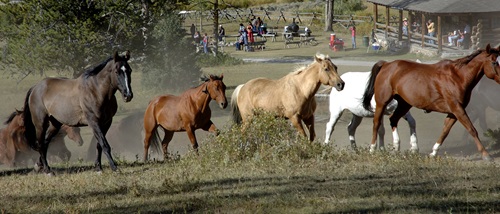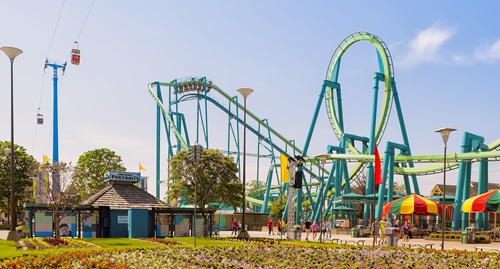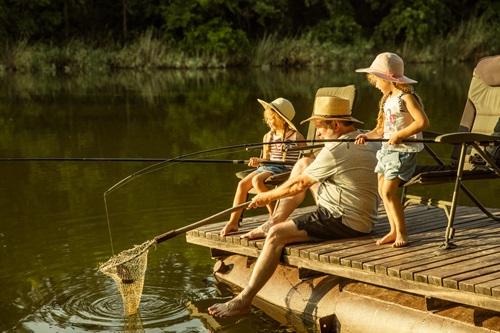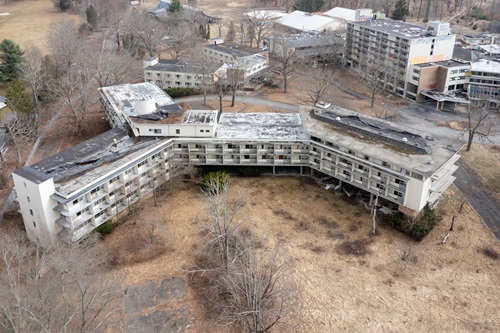
The Caribbean Hotel, a Doo-Wop style motel, is one of many retro style inns found in Wildwood, New Jersey. Photo © James Kirkikis | Dreamstime.com
Despite being wedded to technology (and not wanting to give up connectivity), travelers are on the nostalgia trail, something that is turning into one of the hottest trends.
It’s showing up in a big way as adults move back toward destinations and attractions they themselves loved as kids, with the intention of lighting the flame in their own children.
The trend was first noted by Forbes, where reporters stated, “When times get tough, we look for escapism and there’s no better route to blurring harsh realities than trying to recapture those types of holidays which are rooted in the feel-good factor. Looking for trips which tap into simpler times – whether it is a seaside jaunt or a railway ride – is on the rise.”

Destinations that parents remember from their own childhood vacations, whether these are theme parks, cabins in the mountains, dude ranches or oceanfront boardwalks, are among the favorites mentioned by the travel writers.
Hilton Hotels calls the phenomenon “Time Travel,” citing statistics that say 58 percent of global travelers will revisit childhood destinations, while about 49 percent return to the same place year after year.
Tied into that is sports tourism, adds Hilton, noting, “There is no denying that a sports fan’s loyalty is grounded in traditions. Today, athletes and their fans are hitting the road in record numbers. From 2019 to 2024, Hilton Worldwide Sport Sales revenue tripled in volume—80 percent of which stemmed from youth or amateur sports.”
Even Campspot, a site that compiled lists of campgrounds, states, “From rustic retreats to cross-country caravans, campers are seeking solace in nostalgic travel to nature, and Campspot has dubbed 2025 the year of the (Re)Creation Vacation.”
If this is starting to sound familiar, it may be because you watched a movie years back that dealt with a father bringing his family to a mountain cabin to recreate his youthful experiences. That movie, “The Great Outdoors,” was released in 1988 and proved to be an enormous hit for John Candy, who played the nostalgic dad – and for Dan Aykroyd, who played his materialistic brother who crashed the vacation. (It goes without saying that relationships were rebuilt – but not without plenty of comic mishaps along the way.)
And, says Campspot, nostalgia, and getting it through travel, is something the nation is longing for right now.
The Need for Escape

“In a year dominated by election headlines and digital saturation, Americans are looking for a different kind of escape: a trip back in time. The (Re)Creation Vacation, which combines traditional outdoor recreation with the concept of ‘re-creating’ cherished past experiences, is emerging as 2025’s defining travel trend.”
According to Campspot’s data, 88 percent of survey participants yearn to break free from the complexities of the current era, with 72 percent stating that this longing for a simpler time will strongly influence their travel decisions in 2025.
“Campers today aren’t just looking for a break,” says Erin Stender, CMO of Campspot. “They’re seeking a meaningful way to reconnect with their roots and relive the joyous moments of their childhood. The (Re)Creation Vacation is about more than nostalgia — it’s about actively seeking solace and simplicity in an increasingly complex world.”
Download the insights from Campspot, which cites the way campers are drawing inspiration from the past.
Even among non-campers, say travel writers, we can expect to see a push to recreate experiences from the past, including activities like cookouts, putt-putt golf, fishing, visits to rodeos, boardwalk games, eating in throwback-style diners and even using bus travel.
Nostalgia in Accommodations
The Zoe Report has some prime examples of accommodations and destinations, and its article states “Booking.com notes that these may include landmarks or attractions shown in iconic retro films, or destinations previously popular in the ‘80s and ‘90s.”
One place that combines sports tourism, nostalgia and film locations is the Field of Dreams in Dyersville, Iowa, which hosts not only pro games but youth match-ups.
Another trend in nostalgia tourism is the seeking out of those so-called doo-wop motels that embody the architecture and amenities of the 1950s and 1960s; think: artificial palm trees, lots of neon, balconies and/or themes like the tropics or the space age. (This article in Wikipedia cites Wildwood, New Jersey, as the epicenter of doo-wop motel preservation, with a historic district that includes many of these structures.)

“Many hotels and resorts are tapping into the sense of nostalgia brought on by the rise of vintage clothing and décor,” notes an article in Longitude. “Whether it’s a mid-century modern aesthetic or a more contemporary take on Americana, there are many great examples of hotels throughout America that are tapping into the sense of nostalgia, and road trips of yesteryear.”
Historical and Educational Travel
Some parts of nostalgia tourism involve educational trips to places that simply no longer exist but are an important part of cultural heritage for many people. The camps in the so-called “Borscht Belt,” in the Catskills of New York, were where Jewish families vacationed before they were welcomed by mainstream resorts. (The fictional Kellerman’s in the movie, “Dirty Dancing,” was based on the Jewish camping experience.)
The Borscht Belt Museum in Ellenville, New York, has artifacts and exhibits about those institutions and, in fact, occupies the historic Home National Bank, a 1928 Neo-Georgian structure that was one of the few financial institutions willing to lend to the region's Jewish hoteliers and bungalow colony owners in the 1920s, 30s and 40s.
A movie on Amazon, “Welcome To Kutsher's: The Last Catskills Resort,” examines the phenomenon from the viewpoint of those at the last surviving resort; it was sold and demolished in 2014 – seven years after its 100th season.)
Another example is Henry’s Hotel in Ocean City, Maryland, one of the few places where Black Americans could stay in the resort town. Previously known as Henry’s Colored Hotel, the enterprise was a full service facility catering to visiting African American tourists and entertainers. Cab Calloway, Duke Ellington, Count Basie and Willie Harmon are among the luminaries who performed at the nearby Pier Ballroom but stayed at Henry’s during years of segregation. The beach was restricted as well; reserved periods, known as “Colored Excursion Days,” were limited to weeks after the main summer season had passed.

Birmingham, Alabama has Rickwood Field, the oldest professional ballpark in the United States and former home of the Birmingham Black Barons of the Negro Leagues. This past June, it hosted a Major League game between the St. Louis Cardinals and San Francisco Giants. And while nobody is sorry to see segregation vanish, parents find it instructive and useful for their children to understand what their own families faced.
Sports tourism folds into nostalgia tourism in a big way, according to ResearchGate, which notes, “Nostalgia's role in sport tourism is multifaceted and stems from the nostalgic appeal of sport, tourism and related social experience. Sport, tourism and by extension, sport tourism are useful incubators for nostalgia.”
With sports tourism booming – SDM’s 2024 Champions of Economic Impact in Sports Tourism awards program found that all winners put together had brought more than $1.8 billion into the economy – it’s more important than ever for destinations to play up the nostalgia factor.

